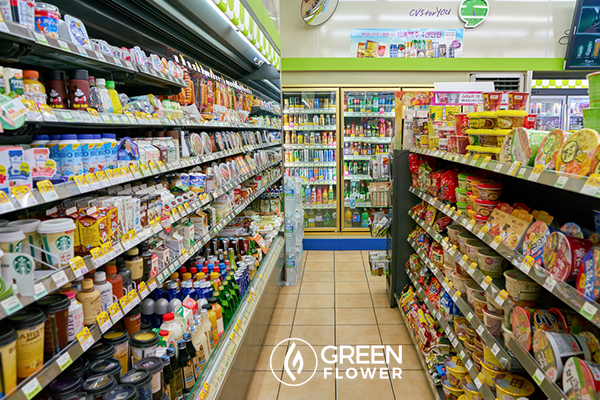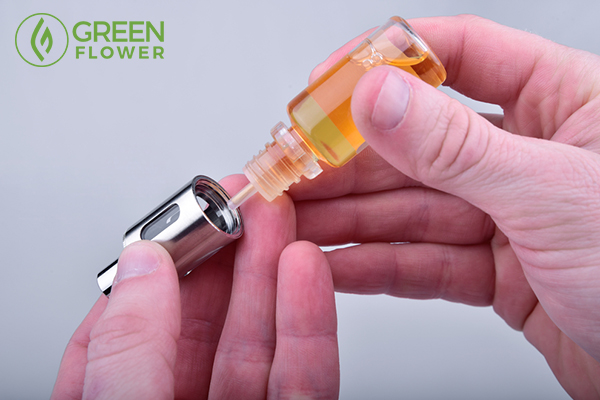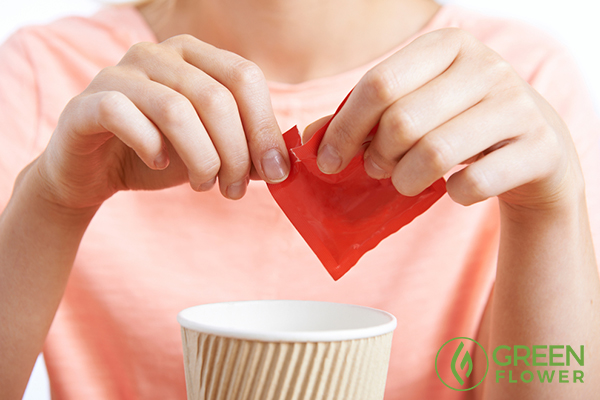
We’ve got 21 problems and cannabis is not one.
Federal cannabis prohibition began in the 1930s, despite the fact that the herb was routinely used in medical and cultural practice.
The decision to prohibit involved zero science-based evidence, which is downright tragic when you think about it.
And what about all the potentially harmful consumer products that are totally legal?
Are synthetic skincare additives and food preservatives more dangerous than cannabis?
Based on emerging research thus far, it would seem so.
To highlight the major doozies, this list calls out 21 substances more dangerous than cannabis that are totally legal.
It’s important to note that this list does not break into the regularly prescribed pharmaceutical drugs, like opioids (painkillers) and benzodiazepines (anti-anxiety medications), which can cause severe side effects and death.
Rather, the items included in this list are everyday consumer goods that many are exposed to on a daily basis.
1. Added sugar

At this time in history, added sugars may be the single most harmful legal substance that is significantly more dangerous than cannabis.
Fruits and whole grains contain natural sugars, which are bound up in fiber, proteins, and fats that help slow the release of sugar in the bloodstream.
Added sugars, however, are included in foods in addition to naturally occurring sugars.
Excess sugar intake is a known contributor to obesity, diabetes, and metabolic syndrome.
Not only do these health conditions cause over 650 million individuals substantial pain and suffering worldwide, but they’re also costly.
In the United States, obesity costs $147 billion annually in medical costs.
Unfortunately, from tomato sauce to iced tea to salad dressing, added sugars are in just about everything. This makes consuming excess added sugar particularly hard to avoid.
Already, sugar has been found to have strong addictive potential.
Sugar has been found to create a dependency response in the brain that is comparable to cocaine, making it tough to give up.
2. Refined grains
Refined grains are more dangerous than cannabis due to the same facts as mentioned above. Refined grains are processed grain products.
That is, they are grain products that have had the bran and germ removed, leaving only the starchy endosperm.
What is that endosperm made of? Glucose.
What is glucose? Sugar.
Excess consumption of glucose that is not bound by adequate fiber, protein, or fat causes dramatic spikes of the hormone insulin in the body.
Insulin is the hormone most closely observed in diabetes patients, as insulin is responsible for shuttling excess glucose into fat cells for storage.
Yet, with excess glucose consumption over time, cells stop responding to insulin.
This, in turn, causes high blood sugar. When blood glucose is too high, glucose begins to attach itself where it doesn’t belong, destroying tissues in the body.
While type 2 diabetes and obesity are complicated conditions that likely have multiple contributing factors, the vast abundance of refined and processed grain products marketed to consumers likely has a major influence on metabolic diseases.
In fact, research has shown an uptick in the prevalence of type 2 diabetes that corresponds to increased availability of refined grains.
It’s important to point out, however, that several population studies have found that cannabis consumption is associated with smaller waistlines, improved insulin sensitivity, and decreased blood glucose when compared to non-consuming controls.
3. Caffeine

While fatal overdoses of caffeine are rare, they do happen.
Caffeine overdoses do not typically happen from coffee, which contains approximately 95 milligrams per 8-ounce cup.
Instead, energy drinks, caffeine-infused foods, and caffeine powders are the more likely culprits.
In fact, in May of 2017, a 16-year-old boy reportedly died after consuming caffeine-infused energy drinks, coffee, and soft drinks.
The death was ruled a caffeine overdose.
While the lethal dose of caffeine will vary from person to person, a study conducted in the 1960s estimated that approximately 200 milligrams per kilogram of body weight can kill you.
For a person that weighs 160 lbs, that’s over 150 cups of coffee.
In contrast, a person of the same weight could smoke over three pounds of cannabis at one time and still not die of a fatal cannabis overdose. To this date, there are no known deaths caused by cannabis overdose.
4. Anti-inflammatory medications
Cannabis has been around for thousands of years. In fact, humans have a relationship with this plant that spans at least the last 10,000 of them.
This dates the human-cannabis relationship to the very beginning of agricultural history. To this date, few major side effects are known.
The same cannot be said for over the counter anti-inflammatory medications.
Some of the most common side effects of non-steroidal anti-inflammatory medications (NSAIDS) include stomach ulcer, heartburn, and excess bleeding.
NSAIDs include medications like ibuprofen and aspirin.
Further, according to the U.S. Food and Drug Administration, at least 103,000 individuals are hospitalized annually due to the effects of anti-inflammatory drugs.
At least another 16,500 NSAID patients die.
5. Energy drinks

Energy drinks contain abnormally large amounts of caffeine.
In 2014, a report published in Frontiers of Public Health found that the large doses of caffeine found in energy drinks were associated with greater risk of late-term pregnancies, physical dependence and addiction.
Increased risks of convulsion, hypertension, and type 2 diabetes were also highlighted as risks of chronic energy drink consumption.
Coupled with the fact that people actually die from energy drink overdoses, it’s safe to say that energy drinks are more dangerous than cannabis.
6. Fast Food
In the United States alone, McDonald’s sells over 550 million Big Macs annually. In fact, apart from french fries, the Big Mac is one of the fast-food chain’s most popular menu items.
A single Big Mac alone contains 50 percent of a total day’s value of fat, 40 percent of the daily value of sodium, and 9 grams of sugars, most of which are added.
Put this in a combo with french fries and a coke, and your sugar intake spikes to a whopping 65 grams.
Already, fast food is thought to be a major contributing factor to obesity, diabetes, and metabolic disorder.
In fact, research from 2005 found that participants who visited a fast food restaurant twice per week instead of once per week gained an average of 10 pounds more and saw double the rates of insulin resistance.
Fast food companies are able to freely put out new products without meeting basic nutritional guidelines, even though it is well understood that these products are actively contributing to disease.
Cannabis possession can still result in imprisonment for many in the United States and can even garner a death sentence in some countries.
Yet, research on cannabis consumption has yet to turn out negative health statistics quite as shocking or costly as those for fast food.
7. Artificial trans fats

While the American Heart Association and the Food and Drug Administration (FDA) have issued warnings asking food companies to reduce their use of hydrogenated and partially hydrogenated oils, many processed foods still contain these ingredients.
What’s wrong with these oils? They are made from unnatural trans fats.
Commonly found in peanut butter and frosting, consumption of hydrogenated vegetable oils has been linked to higher levels of LDL cholesterol, increased risk of heart disease, and increased risk of systemic inflammation.
The worst part? Processed food can contain trans fats even if trans fats are not listed on the nutrition facts label.
Any product that contains hydrogenated or partially hydrogenated oils contains trans fats.
However, food companies are not required to list trans fats on labels if their product contains less than 0.5 grams of trans fats.
That means that a product, like peanut butter, can still contain 0.49 grams of trans fat per serving without having to include trans fats on the label.
This means that an individual can still be exposed to heart-damaging trans fats every day through regular household foods.
8. Propylene glycol (PG)/ Polyethylene glycol (PEG)

PG and PEG are plastic-like thinning agents commonly used in foods, pharmaceuticals, and a variety of everyday objects.
These thinning agents are also frequently used in e-juices and prefilled vaporizer cartridges.
While the FDA categorizes PG and PEG as “generally recognized as safe”, research has found that heating these agents over 446˚F (230˚C) can result in the release of formaldehyde, a well-known irritant and carcinogen.
9. Formaldehyde
Speaking of formaldehyde, the concoction that used to preserve cadavers for scientific research is still legally allowed in certain beauty care products in the United States.
Chemical hair straightening products are some of the biggest formaldehyde offenders, but the chemical can also be found in eyelash glue and nail polish.
As a well-known carcinogen and serious allergen, formaldehyde has already been banned by the European Union as well as in Brazil and several other countries.
10. Antibiotics

While some countries have banned the use of antibiotics in animal feed, the U.S. has not.
Antibiotics are commonly used to fatten up animals before slaughter.
However, the routine use of antibiotics in meat has contributed to increasing numbers of drug-resistant strains of bacteria.
Antibiotic-resistant bacteria pose a major public health risk across the globe.
While the rates of antibiotic-resistant strains are increasing, only two new classes of antibiotics have been introduced in the past 30 years.
This means that more individuals (and animals) get sick and die from infectious disease because we no longer have the means to kill pathogenic bacteria.
Already, 23,000 Americans die each year from antibiotic-resistant infections.
In 2013, the FDA released a new policy banning the continuous use of low-dose antibiotics for plumping agricultural animals.
However, the policy came with a major loophole, allowing farmers to continue to use low doses of antibiotics for “disease prevention,” an act that has already been outlawed in other parts of the world.
11. Artificial sweeteners

The verdict on artificial sugars has gone back and forth over the years. As it stands now, one of the most common artificial sugars, aspartame, is generally recognized as safe by the FDA.
However, past research in animal models has shown a possible link between aspartame and cancer. Though, this research has yet to be supported by larger investigations.
Dizziness, headaches, and stomach problems are also reported side effects of aspartame.
Still, research in the realm of metabolic disease also suggests that aspartame and other artificial sweeteners may still cause spikes in blood glucose that contribute to insulin resistance, a hallmark of type 2 diabetes.
These artificial sweeteners are used to flavor “diabetes-friendly” diet drinks.
12. Teflon
In 2016, the chemical manufacturer DuPont paid out a $5.1 million settlement to an employee who developed testicular cancer after being exposed to a chemical used to make Teflon, the coating which lines non-stick pans.
While the American Cancer Society denies that Teflon itself is linked to the development of cancer, in 2015, over 226 international science professionals signed a statement advocating for the reduction of chemicals used to make Teflon for public health and environmental reasons.
Teflon comes from a synthetic material made from poly- and perfluoroalkyl substances (PFASs).
In the statement, professionals from over 40 countries site preliminary evidence that these materials cause tumors in multiple organ systems, are toxic to the liver, cause low birth weight and size, among many other serious health concerns.
Yet, PFASs continue to line the bottom of nonstick cookware, takeaway containers, and disposable paper plates.
13. Potassium Bromate

Potassium bromate is a compound used in processed bread and bread products to strengthen the dough and extend shelf life.
This substance has been labeled a potential carcinogen by the State of California, as it has been found to cause tumors in multiple organs in laboratory tests in animals.
While baking potassium bromate converts the compound into a non-carcinogenic form, the Environmental Working Group cites evidence that small amounts of potassium bromate still linger in finished bread and bread products.
Interestingly, cannabis compounds have been found to reduce tumor cells in animal models when administered correctly.
The FDA still allows potassium bromate.
14. Tobacco
Speaking of cancer, it is well-known around the world that tobacco contributes to the deadly disease.
Tobacco smoking the leading cause of lung cancer worldwide, contributing to 80 to 90 percent of lung cancer cases.
According to the Centers for Disease Control, tobacco smoke contains over 7,000 different chemical compounds.
70 of these are known to cause cancer in humans and animals.
While the tobacco industry is tightly regulated, the plant is still legal.
Studies comparing the effects of cannabis smoke and tobacco smoke have failed to find the same cancer risks.
Though, the risks of chronic, long-term cannabis smoking have not been adequately assessed. Yet, research has found that switching to a vaporizer successfully reduces the presence of carcinogens in inhaled cannabis.
Thus, tobacco is a substance far more dangerous than cannabis, and it’s totally legal.
15. Alcohol

Ah, yes. Alcohol. As many herb-lovers already know, alcohol is more dangerous than cannabis and yet is totally legal. One of the most favored intoxicants worldwide, alcohol contributes to 2.5 million deaths around the globe each year.
While it’s never fun to sound like a broken record, cannabis has yet to be found as the single individual culprit in even one death.
Alcohol also inspires higher addiction rates than cannabis. While 9 to 10 percent of cannabis consumers risk dependency, that number increases to 15 percent for alcohol.
16. Nitrites and Nitrates
Nitrites and nitrates are preservative compounds added to processed meat.
These substances are often used to maintain color and add flavoring to cured meats, like salami, ham, bacon, sausage, and hot dogs.
While nitrites and nitrates are abundant in processed, foods a growing collection of studies links nitrites and nitrates to increased risks of stomach, esophagus, thyroid, and brain cancers.
The World Health Organization (WHO) has already labeled both nitrites and nitrates as possible human carcinogens, yet these preservatives are still rampant in meat products.
Meat products that do not contain nitrites and nitrates are more expensive than those that do, meaning that low-income individuals and families are the most likely to consume these potentially cancer-causing foods.
In contrast, preclinical and pilot studies have found that cannabis compounds have anticancer properties.
Even in chronic cannabis consumers, a strong link between smoking the plant and increased risks of lung or esophageal cancers have not yet been found.
17. Glyphosate (RoundUp)
Glyphosate is a common herbicide. The most common source of glyphosate is RoundUp, a household weed killer used all over the world.
Recently, measurable levels of glyphosate have been found in Ben & Jerry’s ice cream samples from four different countries, including the U.K., Germany, France, and the Netherlands.
The herbicide was found in a variety of ice cream flavors. In fact 10 of 11 total samples tested included measurable levels of glyphosate.
In recent years, other popular brands, including Quaker Oats and Cheerios have tested positive for glyphosate.
While glyphosate and Roundup have long received criticism regarding potential health and environmental hazards, recent research in laboratory animals has found that glyphosate levels much lower than anticipated triggered fatty liver disease in rodents.
18. Dicamba

Another controversial herbicide ingredient, dicamba, was recently banned in Arkansas but has not been banned by federal bodies. Dicamba is another Monsanto creation.
While the public health effects of this pesticide have not been sufficiently evaluated, Arkansas put forth the ban after receiving over 1,000 complaints that the pesticide was drifting through the air and damaging crops that were not of Monsanto’s genetically modified varieties.
Destroying otherwise viable crops is a threat to the food supply, which has long-reaching economic implications for both farmers who opt not to use GMO products or dicamba as well as for consumers hoping to save at the grocery stores in coming years.
Economic hardship and high food prices are two of the largest contributors to public health issues.
While products like dicamba create the potential for economic hardship, states with legalized cannabis have seen a boom in revenues and tax dollars from cannabis reform.
Thus, pesticides like dicamba that cause economic and public health harm are legal while a substance which arguably improves public health and encourages economic prosperity is not.
19. Parabens
Parabens are synthetic preservatives commonly found in cosmetics, deodorants, shampoos, skincare products, foods, and beverages.
In fact, some research suggests that as much as 90 percent of processed consumer goods contain paraben preservatives.
Over the past several years, there has been a growing concern over the effects of chronic and long-term exposure to parabens.
Of particular concern are the effects of parabens on the hormonal and immune system.
A small study from 2004, for example, found measurable levels of parabens in 19 out of 20 breast cancer cases.
Since parabens are suspected human carcinogens and may have unwanted immunological effects, the European Union has already banned the use of several parabens in consumer goods.
However, these preservatives are unchecked and used rampantly in consumer products in the United States.
20. Phthalates
Phthalates are chemicals added to plastics and used in beauty products and nail polishes to improve consistency and flexibility.
Like parabens, the European Union has already restricted the use of phthalates because emerging evidence suggests that they are possible human carcinogens.
Yet, like parabens, phthalates are rampant in U.S. consumer goods.
Research suggests that phthalates are endocrine disruptors, meaning that they interrupt hormonal systems in the body.
According to the Centers for Disease Control (CDC), phthalates have already been found to cause reproductive issues in rodent models.
The effect of phthalates on the endocrine system is one reason why these compounds are thought to contribute to life-threatening diseases like breast cancer.
Indeed, recent research on exposure to phthalates and breast cancer risk in Mexico has found a correlation between the two. The research included over 500 total women.
In contrast, cannabis compounds have been shown to induce cell death in breast cancer tumors both cultivated in the lab and in animal models. These findings are referenced on the National Cancer Institute webpage.
Are phthalates more dangerous than cannabis? In terms of cancer risk, it would appear so.
21. Fragrance

“Fragrance” is a generic term for an unknown combination of many different chemical compounds, including phthalates and another known irritant, styrene.
Early studies have linked exposure to styrene to increased risks of leukemia and lymphoma.
However, more detailed studies have yet to be completed, so styrene has not yet been labeled a possible human carcinogen by the environmental protection agency (EPA).
Right now, companies are not required to list the chemical ingredients used in generic “fragrance”, meaning that consumers who purchase scented soaps, body care, perfume, and cosmetic products may routinely apply small doses of potentially carcinogenic compounds daily.
Companies are able to pick and choose from around 3,999 different chemicals when creating “fragrance.” These chemicals do not need to be listed on ingredient lists.
Is an unknown chemical concoction containing possibly carcinogenic compounds more dangerous than cannabis? It certainly seems so.
– This article was originally posted at Green Flower
About CannabisNewsWire
CannabisNewsWire (CNW) is an information service that provides (1) access to our news aggregation and syndication servers, (2) CannabisNewsBreaks that summarize corporate news and information, (3) enhanced press release services, (4) social media distribution and optimization services, and (5) a full array of corporate communication solutions. As a multifaceted financial news and content distribution company with an extensive team of contributing journalists and writers, CNW is uniquely positioned to best serve private and public companies that desire to reach a wide audience of investors, consumers, journalists and the general public. CNW has an ever-growing distribution network of more than 5,000 key syndication outlets across the country. By cutting through the overload of information in today’s market, CNW brings its clients unparalleled visibility, recognition and brand awareness. CNW is where news, content and information converge.
To receive instant SMS alerts, text CANNABIS to 21000 (U.S. Mobile Phones Only)
For more information please visit https://www.cannabisnewswire.com
Please see full terms of use and disclaimers on the CannabisNewsWire website applicable to all content provided by CNW, wherever published or re-published: http://CNW.fm/Disclaimer
Do you have a questions or are you interested in working with CNW? Ask our Editor
CannabisNewsWire (CNW)
Denver, Colorado
www.cannabisnewswire.com
303.498.7722 Office
Editor@CannabisNewsWire.com
This article contains Third-Party Content submitted by third parties, including articles submitted through the CNW Premium Partnership Program. All opinions, statements and representations expressed by such third parties are theirs alone and do not express or represent the views and opinions of CNW or its affiliates and owners. Content created by third parties is the sole responsibility of such third parties, and CNW does not endorse, guarantee or make representations concerning the accuracy and completeness of all third-party content. You acknowledge that by CNW providing you with this internet portal that makes accessible to you the ability to view third-party content through the CNW site, CNW does not undertake any obligation to you as a reader of such content or assume any liability relating to such third-party content. CNW expressly disclaims liability relating to such third-party content. CNW and its members, affiliates, successors, assigns, officers, directors, and partners assume no responsibility or liability that may arise from the third-party content, including, but not limited to, responsibility or liability for claims for defamation, libel, slander, infringement, invasion of privacy and publicity rights, fraud, or misrepresentation, or an private right of action under the federal securities laws of the United States or common law. Notwithstanding the foregoing, CNW reserves the right to remove third-party content at any time in its sole discretion.



















